Talk to our experts
1800-120-456-456
- Rural Administration in India


Introduction
The smallest unit of the Indian democratic system is the village or the rural area. The rural sector makes up over 65% of the total population of the country, and in the context of administration, it is an enormous challenge. The urban sector is in a better and more advanced state technologically but it is not the case in the rural sector.
That being said, since independence, the legal system of the country has always taken into account the importance of the governance of this sector as it represents a majority of the global population. Due to this, India has a robust governance system in the rural sector, which shall be explored in this article.
Rural Administration Meaning
Rural administration refers to the initiatives undertaken by the government to govern the public affairs of the rural population and administer to them the benefits the state provides. It has different layers and divisions of different authorities for districts, taluks, villages and towns. Each of these sections has authorities such as police officials, a district collector, tahsildars and patwaris. All of these form a coherent part of the entire rural administration effort by the state, and each one compliments the other.
The PRI, also known as the Panchayati Raj Institution, is an example of the system of indigenous self-government in the rural setting of India.
The police play a very important role as they are the primary body of authority that people in rural areas approach whenever any dispute arises. These disputes and conflicts usually arise between two different parties, who then proceed to file a complaint in the nearest police station. The role of the police then would be to maintain law and order and take action to enforce the same. Empowered by the Police Act of 1861, they have the right to investigate, interrogate and arrest people on the basis of whatever complaint has been filed.
Complications usually arise because there is inherent mistrust in the system. Take for example land disputes. In rural areas, the ownership of land sometimes follows years of inherited land. Hence, the land records might not be accurate. In addition to this, the police system is corrupt, and landlords who have money also control the police. These are all problems rural people face, apart from negligence by policemen, or they simply refuse to file complaints out of lethargy or disbelief. Due to this, there need to be more layers of enforcement, or, more authorities to perform roles.
A Patwari is an individual who takes charge of land records. Across the country, the Patwari is referred to by different names in different languages. Examples of such names include Lekhpal-Kanungo, Karamchari, etc. A Patwari is assigned a cluster of villages, and they maintain the records for that entire region. They are also tasked with the ability to measure farms and agricultural fields, coordinate revenue collection on the land, and furnish details of the crops being grown in these fields.
Tehsildars and Talukdars
Tehsildars and Talukdars are the officials who keep an eye on the Patwari as they hold a powerful position that can be misused. While each Patwari is assigned a set of villages, the rural sector is also organized into tehsils, which are subdivisions within the district. Depending on the size, there are also certain divisions known as taluks. The head of a taluk is the Talukdar and the head of a tehsil is the Tehsildar.
They take charge of the various Patwaris organized within each tehsil/taluk. They are in charge of ensuring that proper data of revenue and land records are maintained. They ensure the farmer has proof of his payment, students have caste certificates and other such documents. They also hear land disputes in their offices. There is also an official above these two positions, known as the District Collector, who is the head of the entire district.
District Collector
They are the head at the district level who are above the Tehsildar or Talukdar and supervise the whole district under them. Mostly they get this post by clearing one of India's toughest examinations of UPSC and by becoming IAS officers.
They control and supervise all the villages under them.
They maintain law and order in the whole district.
They implement government laws and policies and programs in the district.
(ImagewillbeUploadedSoon)
More About Rural Administration in India
India is a big country that is divided into multiple divisions such as states or Union Territories, districts, tehsil or taluk, and villages or cities. Our country is composed of several villages. A village is an area that is underdeveloped or is not that much developed as compared to the urban areas and where all the facilities are not there in a sufficient manner and where agriculture and other allied activities are considered as the main livelihood. There are several villages under one district. How all these villages are managed? We will see below how the rural administration in India works in this article.
Chapter Story: A Quarrel in the Village
The chapter begins with the story of Mohan and Raghu, both farmers who owned adjacent lands separated by a small boundary called the bund. One day, Raghu shifted his border to include some of Mohan's land. Then Mohan decided to ask Raghu, he denied the allegations and had Mohan beaten up with the help of his workmen.
Role of Police
Chapter story: area of the police station.
With nothing left to do, Mohan went to the local police station with eye-witnesses to lodge a formal complaint. Although he knew that Raghu might have influenced the local police, he couldn't even register a complaint at some other police station because every police station has a specific area under his control. Every individual residing in a specific area may report cases or inform the local police of any theft, accident, injury, conflict, etc. It is the responsibility of the police station of that area to interrogate, investigate and take action on cases within its area.
Chapter Story: The Work at Police Station
Although the police did not initially believe Mohan, the case was filed on the protests of other villagers. It would have been possible to resolve this argument more peacefully if records were maintained about who owned how much land in the village. Comparing land records with current measurements would have proved that Raghu took up Mohan's land.
The Role of the Police in the Administration is mentioned below in Points:
Police help in solving the conflicts between the two parties in the village.
We can file a complaint by directly going to the police station in our area.
The police of your area s have to interrogate, investigate and take action on cases within the area.
The maintenance of law and order in the area is the duty of the police.
But sometimes, things do not go the right way. People sometimes are scared to go to the police station and file a complaint. If someone files a complaint, the big landlords convince the Police personnel. In some cases, the police also work inefficiently and do not file the complaints of poor people.
Role of Patwari
Maintenance of Land Records: Assessing the land and maintenance of the record is the primary job of the Patwari who is known by different names in different states. In certain villages, such officers are known as Lekhpal-Kanungo or Karamchari or Village Officer, and so on.
Each Patwari is responsible for a cluster of villages and maintains and updates the village records.
It has means of measuring agricultural fields. A long chain is often used in many places.
Patwari is responsible for coordinating the collection of land revenue from farmers and delivers the government with details on crops grown in the area.
Role of Tehsildar or Talukdar
Who keeps a check on the patwari? Each state in India is divided into districts for land-related management, and these districts are also subdivided. These district subdivisions are known by various names, such as tehsil, taluka, and so on. Tehsildar is called the head of the tehsil whereas Talukdar is the head of the taluk.
They make sure that data is properly maintained and land revenues are collected.
They also ensure that farmers easily receive a copy of their records and students obtain their caste certificates and much more.
The Tehsildar office is where the land dispute issues are heard.
They keep checking on officers subordinates like patwari.
They maintain law and order.
Farmers who own land are often men, while women work on the farm but do not own agricultural land. In some regions, Hindu women have not acquired a share of the family's agricultural land. After the father’s death, the property is divided equally between the sons. The law has recently been changed. According to the new legislation, sons, daughters, and mothers have an equal share of land and the same law applies to all States and Union territories of the country. A huge proportion of women will benefit from this law.
Hindu Succession Amendment Act (2005)
This Act was passed to eliminate the gender discriminatory provisions of the Hindu Succession Act, 1956 and to grant the following rights to daughters under Section 6: The daughter of a coparcener (joint-heir) by birth becomes a coparcener by right in the same way as the son. The daughter has the same rights in the coparcener's property as she would have had if she had been a son.
Thus, in this article, we have learned about rural administration in India. We have covered the whole rural administration introduction and have learned what are rural areas, what administration means, and how rural administration works.
We have also learned rural administration meaning, rural administration definition, the role of police, patwari, tehsildar or talukdar, district collector, and related law which helps in the administration of the rural areas. This article will help you in getting the basic idea of administration in the rural areas of the country.
FAQs on Rural Administration in India
1. Is there a difference between a Tehsildar and a Talukdar?
Districts are organized into subdivisions, of which tehsils and talukas are two names for each subdivision. They are both representative of divisions of the district of similar sizes, but they have no difference in terms of rank. They are simply different names for the same thing. The head of a taluk is a Talukdar and the head of a tehsil is a Tehsildar.
2. Is the rural administration system holistic?
One of the primary focuses of the administration of rural areas is the governance of land, as land disputes are the majority cases that arise in rural areas. Also, since the literacy rate is lower, there is scope for rampant corruption and exploitation of the rural population. Hence, the officials in charge of the administration of rural areas need to be held accountable. That is why the rural administration system is quite holistic.
There are Patwaris who maintain land records and provide information wherever required, which ensures the police do not step out of line. There are Tehsildars or Talukdars who see that the Patwaris do not become corrupt. At the highest level, the district collector watches over the functioning in a seamless manner.
3. Why is there an inherent mistrust in the police system?
This is not true for just rural areas, but even in general, due to the rampant corruption within the system that creates a divide between the haves and the have-nots, police brutality, and the stigma surrounding certain issues, people from middle and low-income backgrounds seldom approach the police with complaints.
This is why it is important for additional checks and balances to be issued to ensure the needs of the people are taken care of. For issues apart from land disputes, unless there are similar officials as patwaris and talukdars assigned, there will continue to be mistrust in the police because of abuse of power.

Reimagining rural policy: Organizing federal assistance to maximize rural prosperity
Download the full policy brief
Subscribe to the Sustainable Development Bulletin
Anthony f. pipa and anthony f. pipa senior fellow - global economy and development , center for sustainable development natalie geismar natalie geismar former senior project coordinator and policy analyst - global economy and development , center for sustainable development.
November 19, 2020
As the 2020 election showed, America’s political polarization is as deep as ever. But the differences among America’s metropolitan and small-town communities are not always ideological, but informed by decades of divergence in prosperity between the nation’s booming cities and its rural areas.
As rural communities adapt to 21st century shifts in the national and global economy, demographics, and climate, the fallout from COVID-19 and the attention to racial injustice adds new urgency to their situation. A recovery from COVID-19 that strengthens America’s economic resilience and prosperity, reduces its social vulnerabilities, and addresses long-standing racial and social inequities will require policies that enable more diverse places —as well as people —to thrive.
Rural America boasts a rich diversity of identity, employment, culture, and experiences. People of color comprise 21 percent of the rural population; rural areas have higher self-employment rates than urban counterparts; and rural assets will be central to modernization and transition underway in several of the nation’s key industries. 12 Yet rural people and places also face unique vulnerabilities: Their recovery from the 2008 recession was incomplete before COVID-19 hit, and they lag other areas on indicators of poverty, health, and education. 34 Many distressed rural communities are those where racial inequities dominate.
In a nation where long-term poverty and economic distress concentrate disproportionately among people of color in rural areas, it is impossible to disentangle rural development from efforts to promote economic and racial justice. It is time to consider geographic equity as a key element of a long-term equity agenda.
Federal assistance for rural development is outdated, fragmented, and confusing
The federal programs and tools available today to promote rural economic and community development serve as a reminder of active federal involvement in the 20th century. Yet they are outdated, fragmented, and incoherent.
Over 400 programs are open to rural communities for economic and community development, spanning 13 departments, 10 independent agencies, and over 50 offices and sub-agencies. A total of 14 legislative committees have jurisdiction over the authorizing legislation for these programs. While the U.S. Department of Agriculture is charged with coordinating federal rural policy, these programs go far beyond its authority—similarly, today’s rural policy must go far beyond agricultural policy. For programs open to many different sized communities, rural communities often deal with spending formulas or eligibility requirements that are particularly disadvantageous to them.
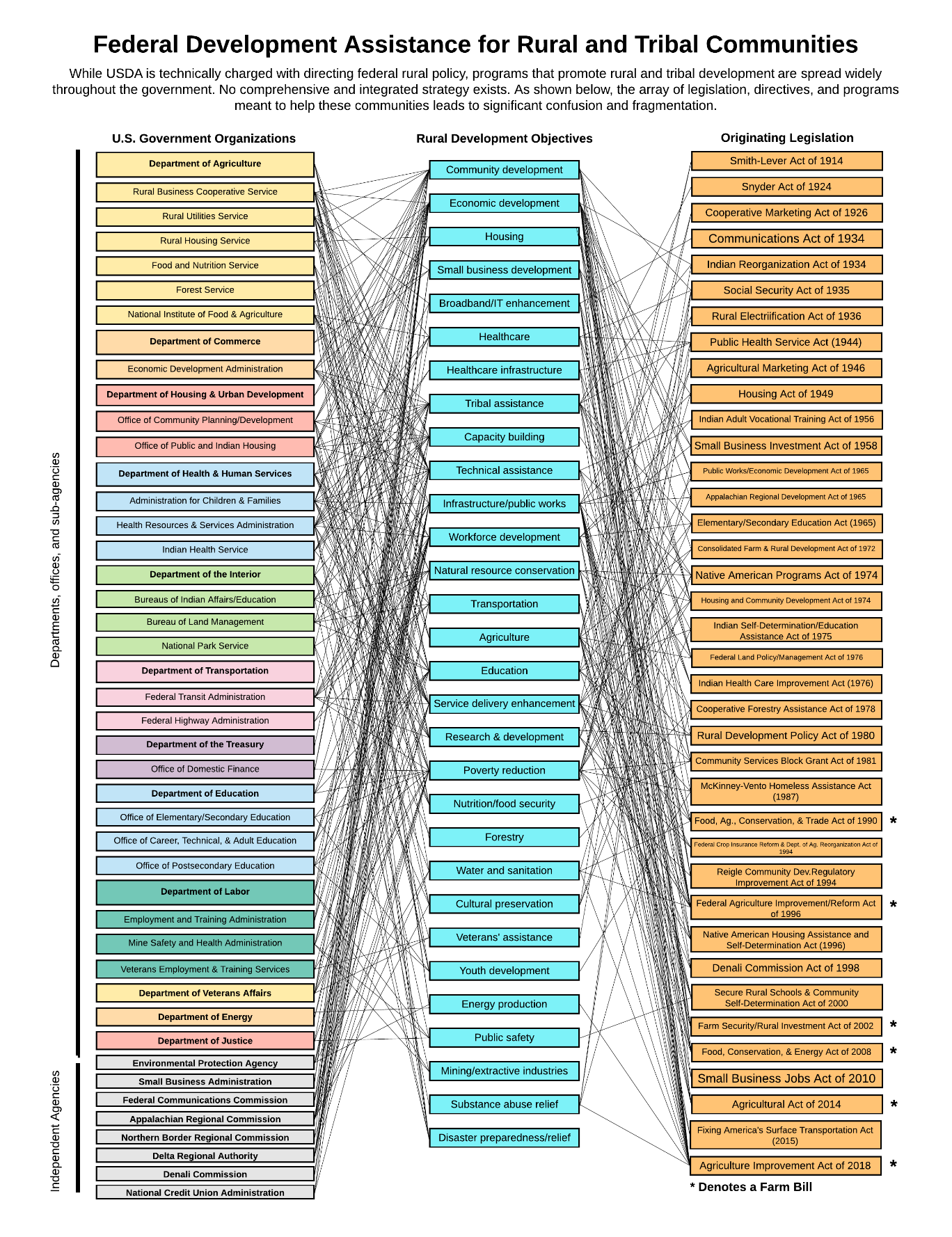
Source: Brookings analysis of the 2019 Catalog of Federal Domestic Assistance
Note: Due to space constraints, this visualization excludes a small number of sub-agencies and offices that administer rural and tribal development programs. Lines drawn directly from department names account for programs administered by sub-agencies and offices that do not appear in the chart.
We tracked fiscal year 2019 funding flows for 93 of these programs, which exclusively target rural communities. They administered $2.58 billion in grants (just 0.2 percent of federal discretionary spending) versus $38 billion in loan authority.
FY2019 grant spending on rural-exclusive development programs, by agency

Note: USDA = U.S. Department of Agriculture, DOT = Department of Transportation, HHS = Health and Human Services, ED = Department of Education, DOI = Department of the Interior, DOL = Department of Labor, ARC = Appalachian Research Commission, DOJ = Department of Justice, VA = Department of Veterans Affairs
Loan authority accounts for the vast majority of rural-exclusive development assistance

Source: Brookings analysis of USASpending data and USDA-RD FY2021 budget summary
The urgency of challenges facing rural communities makes a strong case for ambitious federal leadership to support economic and community development in the rural United States. To maximize the return on federal investment, our recommendations include:
1. Launch a domestic development corporation, modernizing technical capabilities and financing tools
A new corporation would competitively award large, flexible block grants that invest in local vision, accompanied by cutting-edge technical assistance, rigorous analysis and measurement of results, and support to strengthen local leadership and civic capacity. It would integrate and expand the breadth of domestic development financing tools , bringing strategy and improved impact to the set of narrowly defined and siloed tools that currently exist. The U.S. government has done this successfully for its international development investments by creating the Millennium Challenge Corporation and the International Development Finance Corporation; it should apply this experience to the development challenges facing rural communities in the U.S.
2. Create a national rural strategy and undertake associated reforms to improve coherence, regional integration, and transparency
As early as the 1970s, officials in the Carter administration noted that “the federal rural development effort consisted of programs, rather than policy.” 1 A national rural strategy will strengthen coordination by providing clear policy direction to the agencies and stakeholders involved in rural development.
To ensure that strategy implementation responds to rural realities, we recommend elevating White House leadership by (1) establishing high-ranking positions responsible for rural and tribal development and (2) creating an office to facilitate interagency coordination and provide consistency and convening power across presidential administrations.
Related Content
Anthony F. Pipa, Natalie Geismar
Katharine Ferguson, Anthony F. Pipa, Natalie Geismar
April 14, 2020
To be successful, a national rural strategy must embrace diverse rural perspectives while breaking down urban-rural divides by incentivizing regional approaches . An analysis of the impact, constraints, and successes of the seven regional commissions and authorities previously authorized would be a start. Special attention should be paid to addressing power dynamics that have historically excluded groups, and to promoting collaboration with a wide range of partners and intermediaries.
To complement the national strategy and ensure that rural areas have fair access to the federal assistance that can help advance their priorities, we suggest a federal rural audit— a close examination of eligibility, funding formulas, and spending criteria of community and economic development programs, identifying those that disadvantage or create barriers to entry for rural areas.
Coherent strategy requires a rigorous focus on transparency and results. To increase transparency, we recommend an easy-to-use web tool that tracks federal funding flows to rural people and places . We also recommend a congressional commitment to mandate and provide 5 percent of program funding for evaluation.
3. Appoint a bipartisan congressional commission to undertake a top-to-bottom review and build bipartisan momentum for improving the effectiveness of federal rural policy
The scale of operational and structural changes needed to make meaningful improvements will depend upon support and actions from both the legislative and executive branches, and from both political parties. To build and sustain momentum for the scale of change suggested in this analysis, we recommend a bipartisan, congressionally appointed commission undertake a top-to-bottom review of the effectiveness of federal assistance for rural community and economic development.
- Anne Effland, “Federal Rural Development Policy since 1972,” Rural Development Perspectives 9, no. 1 (1993): 8–14, https://naldc.nal.usda.gov/download/IND20388541/PDF
Economic Development
Global Economy and Development
Center for Sustainable Development
Sarah A. Binder, Naomi Maehr, Mark Spindel, Audrey Wang
October 22, 2024
William A. Galston
Benjamin H. Harris, Fred Dews
October 16, 2024

An official website of the United States government
Here’s how you know
Official websites use .gov A .gov website belongs to an official government organization in the United States.
Secure .gov websites use HTTPS A lock ( Lock A locked padlock ) or https:// means you’ve safely connected to the .gov website. Share sensitive information only on official, secure websites.
History of Rural Development
Dr. Karama Neal shares her experience as the former Assistant Administrator for Rural Business Cooperative Service.
The Story of Rural Development
- 1930s Rural Electrification Administration
- 1930s Farmers Home Administration
- 1960s The War on Poverty and the Expansion of Rural Policy
- 1990s Creation of the USDA Rural Development Mission Area
- Today USDA Rural Development in the 21st Century
The U.S. Department of Agriculture’s (USDA’s) Rural Development mission area offers more than 70 programs and initiatives that support rural families and farmers impacted by domestic and global economic issues. However, Rural Development is more than just a set of federal programs. We strive daily to improve the lives of those who live and work in rural communities.
Rural America is important to our nation. Its communities are innovative and resilient. And, rural America has an abundance of natural resources that help ensure our country has the food, fiber, and fuel it needs to power our economy.
Modern-day USDA Rural Development is rooted in the Great Depression and the economic hardship that devastated rural and remote communities largely dependent on agriculture. At this time, 44 percent of the population lived in rural areas and 25 percent of the population were farmers. These conditions illuminated the need for federal policies that prioritized America’s farmers and rural communities.
To pull America out of the depths of the Great Depression, President Franklin D. Roosevelt made the New Deal the centerpiece of his administration. While flawed in its systemic exclusion of communities of color, the New Deal – along with President Lyndon B. Johnson’s War on Poverty programs – gave rural communities the resources they needed to rebuild and thrive. Initiatives included improved access to electricity, water, housing, food, and infrastructure that connected our nation to farmers, ranchers, and others living in rural America. With these investments and clear national policies that addressed the needs of rural communities, farmers, ranchers and their urban neighbors, USDA Rural Development was born.
Rural Electrification Administration
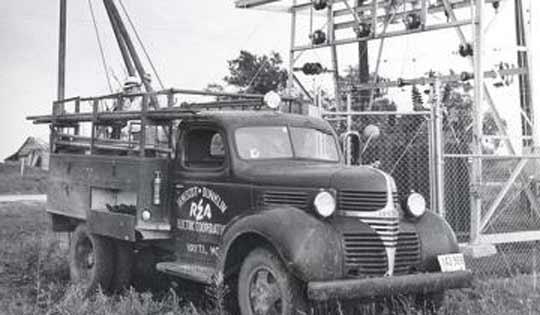
Caption: An REA electric truck setting up power lines during the late 1930s.
During the Great Depression, rural Americans needed the power of electricity that had been established in urban areas. Unfortunately, providing electricity to rural places was cost prohibitive and up to 90% of farmers were not able to access electricity because existing distributors would not build lines to their farms. In 1935, President Franklin D. Roosevelt signed an executive order to create the Rural Electrification Administration, which authorized $410 million to provide loans for rural electrification. Following a successful model of electrification through rural electric cooperatives in Pennsylvania, these loans were targeted towards cooperatives whose missions as non-profit organizations made them farmer-focused rather than profit-focused.
Through the new low interest loans, the cooperatives were able to provide affordable electricity to rural areas and their residents.
In 1936, Congress passed the Rural Electrification Act (REA) that codified the executive order and by the end of 1938, 350 cooperative projects in 45 states were delivering electricity to 1.5 million farms. A lot of the success of rural electrification was not just about the availability of funds to cooperatives, but also the technical assistance and outreach provided by the Rural Electrification Administration. The administration had road shows where staff would go to a community and show how electrical equipment worked. There were also community experts like agricultural engineers or home economists who were on the staff of the local rural system to provide technical assistance to consumers.
In six short years, by 1942, nearly 50% of all farms had electricity, and in 1952, almost all farms had electricity. In 1949, telephone cooperatives were brought into the Rural Electrification Administration, and by the mid-1970s, more than 90% of farms had electricity and telephone service. This successful model of relying on rural electric cooperatives to reach rural communities is being replicated today to ensure rural people have access to high-speed internet and all the benefits and opportunities it can bring to their homes and communities.
Farmers Home Administration
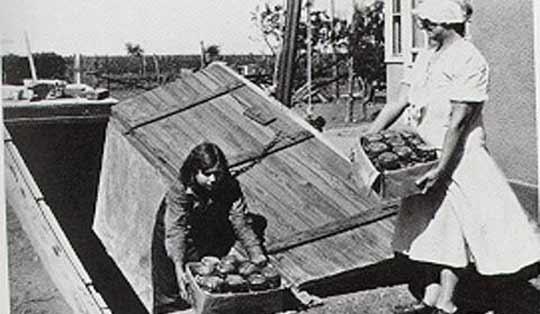
Caption: A child and mother stock up the cellar with canned foods in the late 1930s
While the Rural Electrification Administration was working to ensure rural Americans had access to electricity, a simultaneous effort was underway to address housing and public infrastructure needs in rural America. In 1935, at the height of the Great Depression, President Franklin D. Roosevelt created the Resettlement Administration through Executive Order 7027 to resettle farmers and migrant workers whose agricultural lands were devastated by drought, particularly those prairies affected by the Dust Bowl. To help improve administration of its programs, the Resettlement Administration was eventually transferred to the Department of Agriculture, established by another President facing incredibly challenging times.
President Abraham Lincoln established the U.S. Department of Agriculture nearly 75 years before the Great Depression and nicknamed it “The People’s Department,” making it a logical home for farmer support programs. The Resettlement Administration became the Farm Security Administration and worked to modernize rural America, encouraging farmers who survived the dust bowl to develop more efficient methods of farming.
At the same time, Congress passed the Bankhead-Jones Farm Tenant Act in 1937 which authorized a credit program to help tenant farmers buy land. When World War II began, the large need for workers to aid the war effort in America’s cities left the Farm Security Administration programs underutilized. In addition, large Southern plantation owners were staunchly resistant to the Farm Security Administration’s support of tenant farmers and sharecroppers. This backlash led the way for the Farm Security Administration to be replaced by the Farmers Home Administration (FmHA), which supplemented grants with loans, and extended credit to farmers, low-income individuals, and the rural elderly not only to buy farmland, but to support development in rural areas. FmHA often became a last option for farmers who could not secure loans elsewhere.
FmHA would go on to encompass much more than farmer support programs. Water facilities and housing programs were eventually added to FmHA , and the Consolidated Farm and Rural Development Act (ConAct) expanded FmHA’s portfolio to include nonfarm enterprises and to expand eligibility to nonfarm rural residents. FmHA was able to deliver these programs through an extensive network of approximately 1,900 county and district offices staffed by more than 9,000 full-time equivalent employees during the 1980s. Today, USDA Rural Development relies on these boots on the ground to engage with farmers, ranchers, and entire rural communities to partner with them and share its resources.
The War on Poverty and the Expansion of Rural Policy
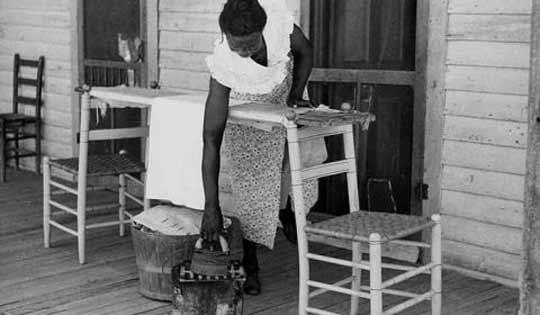
Caption: Housewife ironing in Caruthersville, Missouri in the late 1940s.
During the latter half of the twentieth century, President Lyndon B. Johnson made addressing urban and rural poverty one of the top goals of his presidency. The Johnson Administration understood that rural poverty factored in the out-migration of African Americans from the South to urban cities. It also understood existing agricultural policies were insufficient, on their own, to support rural residents.
Recognizing that rural poverty did not always fall within political boundaries such as state lines, the Johnson Administration addressed these issues regionally.
Their focus on regionalization led to the creation of the Appalachian Regional Commission – a collaborative partnership among 13 eastern states – to promote prosperity across all member states.
The Johnson Administration also created the Rural Community Development Service which centralized the functions of rural economic development under one federal-level umbrella. The service functioned similar to the U.S. Department of Commerce’s Economic Development Administration (EDA). However, the Administration encountered jurisdictional battles between USDA and other organizations – such as the Office of Economic Opportunity – created from President Johnson’s “War on Poverty.”
With a change in administrations, President Johnson’s War on Poverty morphed into President Richard Nixon’s focus on the private sector to promote economic growth. The Consolidated Farm and Rural Development Act of 1972 was the authorizing statute for some of USDA Rural Development’s signature lending and grant programs. These include the Community Facilities Loan program, Rural Business and Industry Loan Guarantee program, and Rural Business Enterprise Grant program.
In 1980, under President Jimmy Carter’s leadership, USDA was officially designated the department to coordinate federal rural policy. This led to the creation of a USDA Undersecretary of Agriculture for Small Community and Rural Development.
While President Ronald Reagan agreed that rural policy was important, his administration enacted significant cuts in rural development programs as part of an effort to reduce the overall size of federal government. During this decade, federal spending on USDA rural programs fell by more than 50 percent. The goal of the Reagan Administration was to shift responsibilities to state and local governments and to the private sector. However, this led to a reduction in critical local services and curtailment of rural economic development plans.
Creation of the USDA Rural Development Mission Area

Caption: Introducing the next generation the power of clean energy.
When President William J. Clinton assumed the presidency in 1992, he tasked his Vice President Al Gore to conduct a government performance review to find opportunities for introducing efficiencies within the federal government. This six-month review concluded in a report called the National Performance Review which called for a government that works better and costs less. The goals of this effort were to continue reducing the size and scale of government, while modernizing and improving the performance of government. The report called for USDA to close 1,200 of its field offices while concentrating its activities on six key functions: commodity programs, rural development, nutrition, conservation, food quality, and research.
The Federal Crop Insurance Reform and Department of Agriculture Reorganization Act of 1994 was the legislation that implemented the actions from the report and separated farm policy from rural policy through the creation of the USDA Rural Development mission area. FmHA farm loan programs were merged with what was the Agricultural Stabilization and Conservation Service to ultimately create what is now Farm Service Agency. USDA Rural Development assumed administration of FmHA’s non-farm functions, comprised of three agencies: Rural Housing Service (RHS), which took the housing and community programs from FmHA, Rural Business-Cooperative Service (RBCS), which merged the business programs from FmHA with the cooperative marketing division known as the Agricultural Cooperative Service, and Rural Utilities Service (RUS), which took the electric and telecom programs from the Rural Electrification Administration and the water programs from FmHA.
This legislation provided an opportunity to consolidate the collection of rural-specific programs and create a mission area that was not just an outgrowth of farm-focused policies. This allowed for better leveraging of programs to more effectively serve the needs of people living in rural America.

USDA Rural Development in the 21st Century

Caption: USDA Secretary Vilsack and RUS Staff at NRECA
Today, USDA Rural Development operates more than 70 programs, delivers over $40 billion a year in loans, loan guarantees, and grants to rural communities, and manages a $200 billion loan portfolio. In 2023, Congress passed the Biden-Harris Administration’s historic legislative package known as the Inflation Reduction Act (IRA) to reduce energy costs for families and create thousands of good-paying jobs for people across rural America. IRA represents the largest single investment in rural electrification since the passage of the Rural Electrification Act in 1936. Sections 22001 through 22005 of IRA provide new loan and grant products and unprecedented incentives to expand clean energy, transform rural power production, create jobs, and spur economic growth to be offered by USDA Rural Development’s Rural Utilities Service (RUS) and Rural Business and Cooperative Service (RBCS).
With 47 state and U.S. territorial offices and dozens of field offices, USDA Rural Development engages with diverse communities throughout the United States and its territories. We’ve also created new divisions – such as the Innovation Center and Business Center – that help us improve service delivery and efficiency.
From our New Deal roots in defining rural policy, to today’s comprehensive and forward-leaning mission area, USDA Rural Development offers an array of tools to help grow rural prosperity. What sets Rural Development apart among federal agencies is that its mission is driven by thousands of USDA employees who work and live alongside the people they serve. These employees not only handle the “nuts and bolts” of loan and grant processing, they also share information that helps rural residents access a variety of other federal, state, and nongovernment resources. Our field-based structure allows USDA Rural Development to administer its own programs and coordinate rural policy across the entire Federal Government. Even so, we understand that a rising tide doesn’t necessarily lift all boats, and we acknowledge there is much more work to be done.
In honoring the diversity and vibrancy of rural America – and by collaborating with rural people who understand the unique strengths and needs of their own communities – Rural Development fulfills its mission. The impact of our programs and services is noteworthy, because – together – we understand that when rural people thrive, all of America thrives.
Rural Administration
There are 6,40,867 villages in India according to the 2011 census! The sheer number is quite staggering itself. The administration of these villages, so that things run smoothly, has to be extremely efficient. Let us take a look at the structure of rural administration of our country and the problems it faces.
- Rural Administration in India
Customize your course in 30 seconds
- Skip to primary navigation
- Skip to main content
- Skip to primary sidebar
UPSC Coaching, Study Materials, and Mock Exams
Enroll in ClearIAS UPSC Coaching Join Now Log In
Call us: +91-9605741000
Panchayati Raj System: Evolution of Local Self-Government in India
Last updated on February 10, 2024 by ClearIAS Team
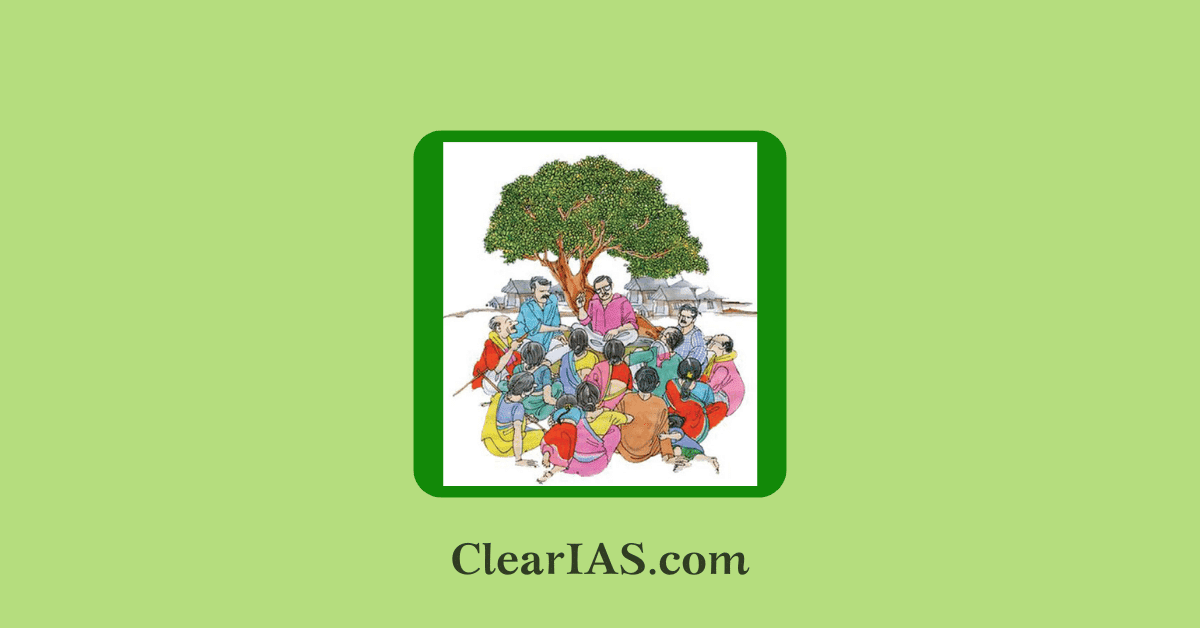
The Panchayati Raj system is a vital component of India’s democratic governance, allowing citizens to participate in decision-making at the local level and contributing to the country’s rural development and grassroots democracy. Read here to learn more about the system.
We know there is a government in India at the Center and State levels. But there is another important system for local governance. The foundation of the present local self-government in India was laid by the Panchayati Raj System (1992).
But the history of Panchayati Raj starts from the self-sufficient and self-governing village communities. In the time of the Rig-Veda (1700 BC), evidence suggests that self-governing village bodies called ‘sabhas’ existed. With time, these bodies became panchayats (councils of five persons).
Panchayats were functional institutions of grassroots governance in almost every village. They endured the rise and fall of empires in the past, to the current highly structured system.
Also read: Punchhi Commission Report
Table of Contents
What is the Panchayati Raj System?
The Panchayati Raj system in India is a decentralized form of government that aims to bring governance closer to the grassroots level by establishing elected local self-government institutions in rural areas.
👉 Which year are YOU targeting for success in the IAS/IPS/IFS Exam? 🚀
(1) ⇒ UPSC 2025: Prelims cum Mains
(2) ⇒ UPSC 2026: Prelims cum Mains
(3) ⇒ UPSC 2027 Prelims cum Mains
Tip: Know more about ClearIAS Courses (Online/Offline)
The term “Panchayati Raj” literally translates to “rule by the five,” where “panch” means “five” and “raj” means “rule.” These institutions play a vital role in local governance, rural development, and participatory democracy.
The Panchayati Raj system in India is organized into a three-tier structure, comprising:
- Gram Panchayat (Village Level): This is the lowest tier and represents a single village or a group of villages. It is the basic unit of the Panchayati Raj system.
- Panchayat Samiti (Block/Mandal Level): The Panchayat Samiti is the intermediate tier that covers a block or a mandal, which typically consists of several villages.
- Zila Parishad (District Level): At the top of the hierarchy is the Zila Parishad, which covers an entire district. It coordinates and supervises the activities of the lower tiers.
History of local administration
The history of local administration in India is a long and diverse one, shaped by the evolution of political, cultural, and administrative systems over millennia. India has a rich tradition of local governance dating back to ancient times, and this system has evolved through various dynasties, empires, and colonial periods.
Ancient Period:
- In ancient India, the political landscape was divided into numerous Janapadas, or small kingdoms and republics. These Janapadas had their systems of local governance, with councils and assemblies known as “Sabhas” and “Samitis” that handled administrative and judicial matters.
- Under the Mauryan Empire (322-185 BCE), Emperor Ashoka established a system of local administration with officials known as “Mahamatras” responsible for the welfare of the people in various regions. He also inscribed edicts on pillars and rocks to communicate his policies to the local population.
Medieval Period:
- Feudal System: During the medieval period, India experienced the emergence of feudalism . Feudal lords and local chieftains governed their territories with varying degrees of autonomy. The Delhi Sultanate and later the Mughal Empire introduced the system of “jagirs” or land grants to nobles in exchange for revenue collection and military service.
- Local Chiefs and Rajas: Regional rulers, such as Rajas and Zamindars, exercised local authority and governed their territories independently, often collecting revenue from peasants.
Colonial Period:
- The British East India Company and later the British Crown introduced a centralized administrative system that significantly altered local governance. They established a revenue collection system, where land revenue was collected directly from peasants or through intermediaries known as zamindars .
- The British also introduced local self-government institutions such as municipalities and panchayats. The Montagu-Chelmsford Reforms (1919) and the Government of India Act (1935) allowed for some degree of local representation in governance.
The village panchayat, as a system of administration, began in the British days, as their offer to satisfy the demands for local autonomy.
They opened up the governance of the lowest levels to the citizens. The GoI Act, of 1935 also authorizes the provinces to enact legislation .
Evolution of local self-government in India
Even though such minor forms of local governance were evident in India, the framers of the constitutions, unsatisfied with the existing provisions, included Article 40 among the Directive Principles , whereby:
“The state shall take steps to organize village panchayats and endow them with such powers and authority as may be necessary to enable them to function as units of self-government.”
Later, the conceptualization of the system of local self-government in India took place through the formation and effort of four important committees from the year 1957 to 1986. It will be helpful if we take a look at the committee and the important recommendations put forward by them.
Balwant Rai Mehta Committee (1957)
Originally appointed by the Government of India to examine the working of two of its earlier programs, the committee submitted its report in November 1957, in which the term ‘ democratic decentralization ‘ first appears.
The important recommendations are:
- Establishment of a three-tier Panchayati Raj system – gram panchayat at the village level (direct election), panchayat Samiti at the block level, and Zila Parishad at the district level (indirect election).
- District Collector to be the chairman of Zila Parishad.
- Transfer of resources and power to these bodies to be ensured.
The existing National Development Council accepted the recommendations. However, it did not insist on a single, definite pattern to be followed in the establishment of these institutions. Rather, it allowed the states to devise their patterns, while the broad fundamentals were to be the same throughout the country.
Rajasthan (1959) adopted the system first , followed by Andhra Pradesh in the same year. Some states even went ahead to create four-tier systems and Nyaya panchayats , which served as judicial bodies.
Ashok Mehta Committee (1977-1978)
The committee was constituted by the Janata government of the time to study Panchayati Raj institutions. Out of a total of 132 recommendations made by it, the most important ones are:
- Three-tier system to be replaced by a two-tier system.
- Political parties should participate at all levels in the elections.
- Compulsory powers of taxation are to be given to these institutions.
- Zila Parishad is to be made responsible for planning at the state level.
- A minister for Panchayati Raj is to be appointed by the state council of ministers.
- Constitutional recognition to be given to Panchayati Raj institutions.
Unfortunately, the Janata government collapsed before action could be taken on these recommendations.
G V K Rao Commitee (1985)
Appointed by the Planning Commission, the committee concluded that the developmental procedures were gradually being taken away from the local self-government institutions, resulting in a system comparable to ‘grass without roots’.
- Zila Parishad is to be given prime importance and all developmental programs at that level are to be handed to it.
- Post of DDC (District Development Commissioner) to be created acting as the chief executive officer of the Zila Parishad.
- Regular elections are to be held
L M Singhvi Committee (1986)
Constituted by the Rajiv Gandhi government on ‘Revitalisation of Panchayati Raj institutions for Democracy and Development, its important recommendations are:
- Constitutional recognition for PRI institutions.
- Nyaya Panchayats to be established for clusters of villages
Though the 64th Constitutional Amendment bill was introduced in the Lok Sabha in 1989 itself, the Rajya Sabha opposed it. It was only during the Narasimha Rao government’s term that the idea finally became a reality in the form of the 73rd and 74th Constitutional Amendment Acts, of 1992 .
Panchayati Raj System: 73rd and 74th Constitutional Amendment acts, 1992
The acts of 1992 added two new parts IX and IX-A to the constitution. It also added two new schedules – 11 and 12 which contain the lists of functional items of Panchayats and Municipalities.
It provides for a three-tier system of Panchayati Raj in every state – at the village, intermediate, and district levels.
Read: Panchayati Raj
What are Panchayats and Municipalities?
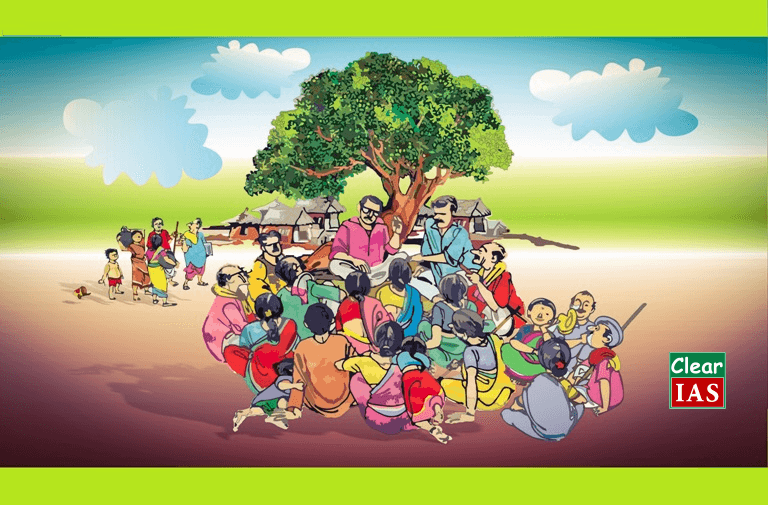
- Panchayat and Municipality are the generic terms for the governing body at the local level. Both exist as three-tier systems – at the lower, intermediate, and upper levels.
- The 73rd Constitutional Amendment Act provides for a Gram Sabha as the foundation of the Panchayati Raj system. It is essentially a village assembly consisting of all the registered voters in the area of the panchayat. The state has the power to determine what kind of powers it can exercise, and what functions it has to perform at the village level .
- Nagar Panchayat for a transitional area between a rural and urban area.
- Municipal Council for a small urban area.
- Municipal Corporation for a large urban area.
- Municipalities represent urban local self-government.
- Most of the provisions of the two acts are parallel, differing only in the fact that they are being applied to either a Panchayat or a Municipality respectively.
- Each Gram sabha is the meeting of a particular constituency called a ward.
- Each ward has a representative chosen from among the people themselves by direct election .
- The chairperson of the Panchayat or Municipality at the intermediate and district level is elected from among these representatives at the immediately lower level by indirect election .
Types of Urban Local Self-Governments
There are eight types of urban local governments currently existing in India:
- Municipal Corporations.
- Municipality.
- Notified area committee.
- Town area committee.
- Cantonment board.
- Port trust.
- Special purpose agency
How are the elections held in the local government bodies?
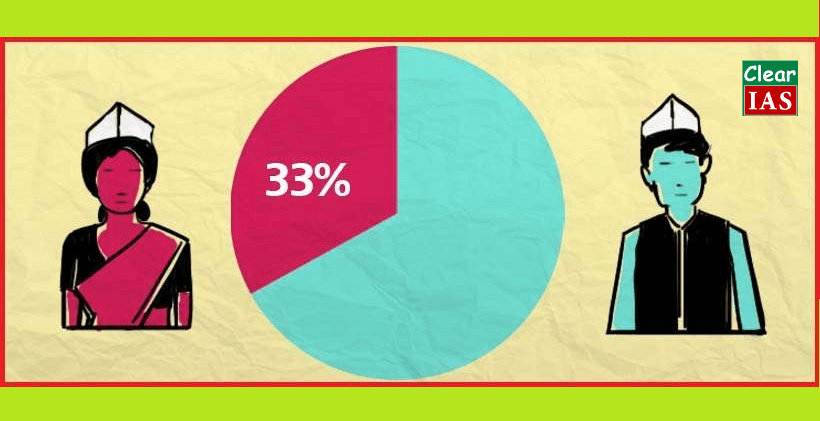
- All seats of representatives of local bodies are filled by people chosen through direct elections.
- The conduct of elections is vested in the hands of the State election commission.
- The chairpersons at the intermediate and district levels shall be elected indirectly from among the elected representatives at the immediately lower level.
- At the lowest level, the chairperson shall be elected in a mode defined by the state legislature.
- Seats are reserved for SC and ST proportional to their population.
- Out of these reserved seats, not less than one-third shall be further reserved for women.
- There should be a blanket reservation of one-third of seats for women in all the constituencies taken together too (which can include the already reserved seats for SC and ST).
- The acts bar the interference of courts in any issue relating to the election of local bodies.
What are the Qualifications needed to be a member of the Panchayat or Municipality?
Any person who is qualified to be a member of the state legislature is eligible to be a member of the Panchayat or Municipality.
“ But he shall not be disqualified on the ground that he is less than 25 years of age if he has attained the age of 21 years”
This means that, unlike the state legislature , a person needs to attain only 21 years of age to be a member of a panchayat/municipality .
What is the duration of the Local Government bodies?
- The local governing bodies are elected for a term of five years.
- Fresh elections should be conducted before the expiry of the five-year term.
- If the panchayat/municipality is dissolved before the expiry of its term, elections shall be conducted within six months and the new panchayat/municipality will hold office for the remainder of the term if the term has more than six months duration.
- And for another five years if the remaining term is less than six months.
What are the Powers invested in these Local Self-Government bodies?
The powers of local bodies are not exclusively defined. They can be tailor-fitted by the state governments according to the environment of the states. In general, the State governments can assign powers to Panchayats and Municipalities that may enable them to prepare plans for economic development and social justice. They may also be authorized to levy, collect, or appropriate taxes.
To conclude, local self-government is one of the most innovative governance change processes our country has gone through. The noble idea of taking the government of a country into the hands of the grassroots level is indeed praiseworthy.
However, like any system in the world, this system is also imperfect. Problems of maladministration and misappropriation of funds are recurring. But this shall not stand in the way of efficient governance; and if these ill practices are rooted out, there would be no comparisons around the world to our system of local self-government.
Read: Finances of Panchayati Raj institutions
Article by: Unnikrishna Varma

Best-Selling ClearIAS Courses
Upsc prelims cum mains (pcm) gs course: unbeatable batch 2025 (online), rs.75000 rs.29999, upsc prelims cum mains (pcm) gs course: ultimate batch 2025 (online), rs.95000 rs.49999, upsc prelims cum mains (pcm) gs course: ultimate batch 2026 (online), rs.115000 rs.59999, upsc prelims cum mains (pcm) gs course: ultimate batch 2027 (online), rs.125000 rs.69999.

About ClearIAS Team
ClearIAS is one of the most trusted learning platforms in India for UPSC preparation. Around 1 million aspirants learn from the ClearIAS every month.
Our courses and training methods are different from traditional coaching. We give special emphasis on smart work and personal mentorship. Many UPSC toppers thank ClearIAS for our role in their success.
Download the ClearIAS mobile apps now to supplement your self-study efforts with ClearIAS smart-study training.
Reader Interactions
February 4, 2017 at 10:44 pm
Amazing wonderful info about 73rd nd 74th article excellent
February 5, 2017 at 12:15 am
thanku sir excellent…….
February 5, 2017 at 9:11 am
helpful post….. thank you ClearIAS for easing aspirant’s job. 🙂
February 5, 2017 at 9:40 am
Excellent sir
February 5, 2017 at 3:58 pm
easy and useful
February 5, 2017 at 10:15 pm
February 5, 2017 at 10:23 pm
The way it describes itself is easy to remember.
February 6, 2017 at 3:29 pm
Easy way to get the knowledge and remember . excellent work .
February 6, 2017 at 4:28 pm
very very nice
February 9, 2017 at 4:30 pm
Thank you, very nice
February 11, 2017 at 11:05 am
Please explain further about the need for a three-tiered system of governance at lower levels viz lower intermediate and higher
Also explain about the need for various types in urban bodiesviz.,municipality, municipal corporation, port trustetc,.-
February 26, 2017 at 10:24 pm
August 28, 2017 at 12:08 am
Super nd detailed information thnx
September 18, 2017 at 11:50 am
Is a gram sabha(formed by one or more villages according to its population) and gram panchayat same? or do we have a gram panchayat for each village irrespective of the number of villages in the gram sabha
November 29, 2018 at 12:10 pm
gram sabha is same Total number of electors are the member of gram sabha.
November 28, 2017 at 7:33 pm
why panchayati raj system is partyless
August 31, 2018 at 7:40 pm
Interesting and easy sir
November 7, 2018 at 11:09 am
where are thungon commitee and gadgil commitee
November 21, 2018 at 11:38 am
How many part of local govt in india
January 16, 2019 at 9:27 pm
greatly defined in brief.
April 15, 2019 at 4:13 pm
Can somebody enlighten me by telling when and where did the first Panchayat Elections took place?
May 24, 2019 at 11:57 pm
Ashok Mehta Committee recommended “a two-tier system” not “three-tier system”. Please edit the info.
August 8, 2019 at 6:11 pm
Nice sir useful to write my civics project
September 3, 2019 at 10:33 pm
Very useful and impotant information…many many thanks for this …
April 15, 2024 at 10:28 pm
Very useful information and content thanks a lot..
Leave a Reply Cancel reply
Your email address will not be published. Required fields are marked *
Don’t lose out without playing the right game!
Follow the ClearIAS Prelims cum Mains (PCM) Integrated Approach.
UPSC Online Preparation
- Union Public Service Commission (UPSC)
- Indian Administrative Service (IAS)
- Indian Police Service (IPS)
- IAS Exam Eligibility
- UPSC Free Study Materials
- UPSC Exam Guidance
- UPSC Prelims Test Series
- UPSC Syllabus
- UPSC Online
- UPSC Prelims
- UPSC Interview
- UPSC Toppers
- UPSC Previous Year Qns
- UPSC Age Calculator
- UPSC Calendar 2025
- About ClearIAS
- ClearIAS Programs
- ClearIAS Fee Structure
- IAS Coaching
- UPSC Coaching
- UPSC Online Coaching
- ClearIAS Blog
- Important Updates
- Announcements
- Book Review
- ClearIAS App
- Work with us
- Advertise with us
- Privacy Policy
- Terms and Conditions
- Talk to Your Mentor
Featured on

and many more...
ClearIAS Programs: Admissions Open
Thank You 🙌
UPSC CSE 2025: On May 25, 2025
Subscribe ClearIAS YouTube Channel

Get free study materials. Don’t miss ClearIAS updates.
Subscribe Now
IAS/IPS/IFS Online Coaching: Target CSE 2025

Cover the entire syllabus of UPSC CSE Prelims and Mains systematically.

IMAGES
VIDEO
COMMENTS
Rural Administration Meaning. Rural administration refers to the initiatives undertaken by the government to govern the public affairs of the rural population and administer to them the benefits the state provides. It has different layers and divisions of different authorities for districts, taluks, villages and towns.
Since the late 1980s, good governance has been a crucial point for programme implementation and decision making for many nations worldwide (Pomeranz and Stedman 2020), including the central, local, and rural local administration.Governance is one of the buzzwords in the development field (Yong and Wenhao 2012) and in modern social sciences (Almqvist et al. 2013).
governance and administration are not easy and straightforward, particularly within rural communities, as they are in an underdeveloped state, as compared to urban communities.
The rural local administration is the right authority to make decisions about future rural development. vggp8 The rural communities trust the rural local administration to manage the rural
Fig. Experts' opinion about positions directly related to administration of rural development management, % age (remark: respondents had a possibility to choose several suitable answers)
The rural population of India, as we know, is quite vast. And they have their unique set of problems and need some kind of guidance to smoothly sail through these. In villages, there are some people in-charge of rural administration in India. Let us take a look.
As early as the 1970s, officials in the Carter administration noted that "the federal rural development effort consisted of programs, rather than policy." 1 A national rural strategy will ...
The Resettlement Administration became the Farm Security Administration and worked to modernize rural America, encouraging farmers who survived the dust bowl to develop more efficient methods of farming. At the same time, Congress passed the Bankhead-Jones Farm Tenant Act in 1937 which authorized a credit program to help tenant farmers buy land.
Rural America often is portrayed in one of two ways. The first recalls quintessential American main streets—safe, friendly, and situated in picturesque landscapes. The second depicts empty storefronts, public health crises, and resentment toward change. Within this complex picture of rural life, however, are municipalities that must be managed.
Rural local governance has emerged as a prominent issue in the literature of Public Administration and is one of the important social inventions of this century. It became an important policy objective during the 1970s and 1980s, as the government in developing countries sought to create more socially equitable ...
this chapter we will look at the work of two rural . administrative officers in some detail. Chapter 5. Rural Administration. M. ohan is a farmer. His family owns . a small agricultural field, which . they have been farming for many . years. Next to his field is Raghu's land . which is separated from his by a small boundary called a bund.
We explore culture-based development projects from three rural communities. We find that local governance strategies vary between relatively similar rural communities and that they represent compromises in terms of socio-economic outcomes. Local government in rural communities can act strategically through use of local networks.
The administration of these villages, so that things run smoothly, has to be extremely efficient. Let us take a look at the structure of rural administration of our country and the problems it faces. There are 6,40,867 villages in India according to the 2011 census!
The Panchayati Raj system is a vital component of India's democratic governance, allowing citizens to participate in decision-making at the local level and contributing to the country's rural development and grassroots democracy. Read here to learn more about the system. We know there is a government in India at the Center and State levels.
India is a country of contrasts, where rapid economic growth coexists with persistent poverty and social problems. The rural areas, which house about two-thirds of the population, are undergoing significant changes in terms of living standards, education, health, and environment.. As India's rural landscape undergoes a transformative journey, marked by a commendable decline in multidimensional ...
Rural administration is faced with the challenges, which have been made the effect of government's ef forts at different levels. Non-government organizations, private initiatives,
Rapid growth: Impacts on the politics and administration of rural governments. In Rural public administration: Problems and prospects, Jim Seroka, ed., 115-136. New York: Greenwood. Google Scholar. ... Papers on the science of administration. New York: Institute of Public Administration. Google Scholar. Hahn, Alan . 1970. Planning in rural areas.
6.10 Establish land administration institutions that are responsive and accommodating to women as well as men. ... 6.25 Identify rural institutions responsible for the implementation of customary rules. This can often be complex and detailed, and may vary between communities. One of the important elements in the project or programme may be an ...
Gram Sabha: The Panchayati Raj, through the Gram Sabha, can solve land dispute problems, instead of taking the issues to the police station. Work at the Police Station: In the police station, Mohan met the Station House Officer and said that he wanted to give the complaint in writing. At first, the S.H.O. refused, but later, he agreed that he would register the case.